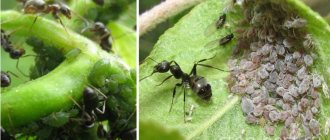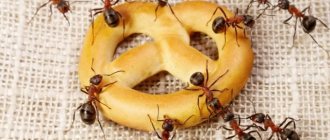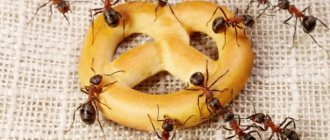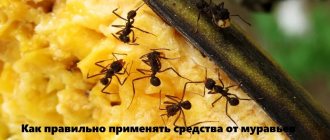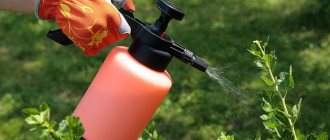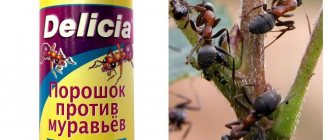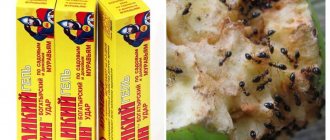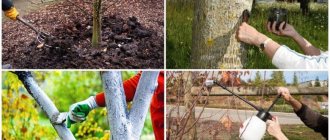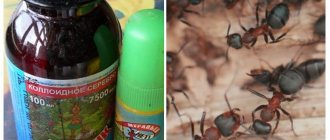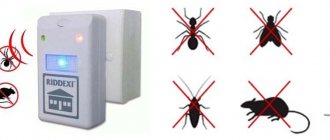A garden is a complex ecological system. Many gardeners are trying to find a way to quickly destroy insects that breed on fruit trees. The symbiotic relationship between aphids and ants has been known for a long time. They are beneficial to both parties: the aphids receive protection from predators, and the ants feed on honeydew, the sweet secretions of the aphids. And if measures are not taken in a timely manner, you can say goodbye to the harvest.
Progressive approach
Folk remedies are completely safe, but their effectiveness does not always live up to expectations.
In some cases, it is necessary to get a quick and guaranteed result. So, for example, when carpenter ants appear on the site. These pests live in wood; in the shortest possible time they can turn not only rotten stumps, but also diseased tree branches or wooden buildings into dust. Also, do not hesitate when the garden is already infested with aphids and ants. In this case, it is worth using proven modern pesticides. Today, insecticides are not only not harmful to warm-blooded animals, but they decompose quickly enough without accumulating in the soil and plants.
In addition to powder and granular products, gels have become widespread. This poison is convenient for ants living on trees; it is easily applied to any surface. It can be used to apply a barrier on the trunk and, crossing the sticky strip, the ants on their paws will carry poison into the anthill. They will also not fail to feast on dangerous treats and feed the larvae and the queen. Today, most manufacturers use a complex of insecticides that combine contact and intestinal action.
Ant repellent gel can be placed directly into the anthill itself. To do this, you need to find the central entrance to the nest, remove 5-7 cm of soil in this place and squeeze the drug into the recess. Then cover the anthill with mud. This method is good because it does not pose a danger to pollinating insects. If it is not possible to find all colonies of pests, then the bait is laid out along the ant trails.
The following drugs have already proven their effectiveness in practice:
But, they should be used on the site with great caution and strictly following the instructions. The insecticides used in them are dangerous to all insects equally, both beneficial and pests.
One of the truly “folk” pesticides is the “Mashenka” chalk. It is successfully used against ants not only in the house and apartment, but also in greenhouses and in the garden. It is applied to cardboard or planks, which are placed in the path of insects. Once the pests have disappeared, they can simply be removed from the area.
Separately, it is worth noting that the advertised electromagnetic and ultrasonic repellers and traps in the garden are completely useless. Ants feel great in their area of action. Conventional sticky traps and containers with insecticides are also ineffective. These products are great in closed spaces, but are designed for a limited range.
You can expect a positive result in the garden only with an integrated approach, counting not only on poisons. To do this, it is necessary to regularly cultivate the soil and fight aphids. Only a fight on all fronts will help you escape from the ubiquitous, hardworking and very tenacious ants on your property and in the garden, without harming the environment or disturbing the natural balance of the ecosystem.
Prevention
In order to avoid the need to take drastic measures to exterminate ants on your site, you need to regularly do the following:
- Look through plant leaves and destroy aphids if found. To do this, just spray the leaves with a special product.
- Regularly dig up the soil to a depth of at least 10 cm.
- Pruning old and diseased tree branches of plants.
- Do not leave boards or pieces of paper on the site; regularly look under stones to check for the possible presence of ants.
- You can plant fragrant plants around the perimeter of your summer cottage. It could be lavender or garlic.
- Ants can destroy a pear or other fruit tree by settling in a hollow or crack in the trunk. It is necessary to inspect such places.
These and other similar preventive measures will significantly reduce the likelihood of ants appearing on the site.
When killing ants, the most important thing is to find the place where the anthill is located. Sometimes it can be determined by monitoring the activity of ants. This will help you get rid of them for a long time. However, it is better to carefully monitor the condition of the area and, at the first alarm, take the necessary measures to clear the ants.
Compositions for treating fruit trees against ants
In an effort to get rid of small pests, you can spray trees with special solutions:
- Prepare a solution from 400 g of black soap, 2 tablespoons of carbolic acid, 10 tablespoons of kerosene and a bucket of warm water. The mixture is sprayed on anthills, as well as the tree itself. Several procedures are necessary for the ants to completely disappear. Additionally, for greater spraying efficiency, it is recommended to coat the trunk near the ground with tar.
- This composition acts not only on ants, but also on other pests. It is necessary to pour 300 g of fresh wormwood or 30 g of a dry bucket of cold water and leave for several hours. Next, it is filtered and, without diluting, the fruit trees are sprayed with it.
- Mix linseed oil in an amount of 30 g with 5 g of soda and dilute in 1 liter of water. Trees affected by insects are sprayed with this composition. This treatment against ants is absolutely safe and does not harm the leaves and fruits.
- An effective remedy for garden pests is regular soda, for example: Coca-Cola. It is necessary to prepare a composition for spraying. To do this, mix 5 parts soda and 1 part water.
Spraying is an effective way to control pests, but you need to remember that you need to spray in dry and preferably calm weather.
Professional traps
If you cannot defeat an ant colony using folk remedies, you should use poison. Control on fruit trees is carried out using:
A suitable product is sold in any hardware or specialty store in a tin tube. It is best to use before the fruit is fully ripe.
Garden glue works similarly, but the difference is the presence of insecticidal agents. Insects can take particles of gel from the trunks with them to the anthill. They eat themselves, feed the larvae and the queen. Within two weeks, the entire ant family dies.
The trunks are coated with gel and the bait is placed on pieces of plywood or plastic. Validity period is about 20 days. Mass deaths are observed within a month.
How to get rid of ants in tree roots
Anthills can be found near the roots of trees in the garden. The damage caused by ants living in such a house is enormous.
While carrying out their activities, insects settle in the roots, gnawing them and depriving the tree of nutrition for young seedlings. If you do not get rid of the neighborhood, the fruit tree will die.
You can protect the tree while planting it. Experienced gardeners create barriers in the ground around the roots. When creating barriers, the habits of smart insects are taken into account. It is known that ants cannot swim. Therefore, water barriers installed under a tree are effective for protecting plantings.
Mini-pools made from old tires cut lengthwise must be laid level with the soil. Replenish the resulting container with water regularly. To increase the effectiveness of protection against ants, you can add used motor oil or tar. According to reviews, this is the best remedy for protecting against ants. Economical, durable and reliable.
Varieties
If we talk about species that are capable of settling in gardens and vegetable gardens, then here you can only find black and red goosebumps.
Redheads
It is worth saying that this species likes to settle closer to people, in other words, they are of little interest to just a garden. They prefer to be adjacent to living quarters, but at the same time they love to eat juicy, sweet fruits. To set up a colony, they choose the voids under houses, crawling through the cracks.
As already mentioned, colonies have not one queen, but several. Their nests are arranged in a rather unique way; there are several of them, each with its own queen, and they are connected to each other by special passages. If we take into account that the queen lives for about 15 years, then we hope that the colony will disintegrate and disappear.
Garden black
Despite the name, individuals of this species may differ in the color of their body. It depends on the habitat and the soil. They can be gray, black, yellow, brown. All of them perfectly adapt to new conditions, can live in absolutely any soil, and are not afraid of climate change and temperature changes.
Colonies grow quickly and, in addition to the fact that anthills are located in gardens and vegetable gardens, they can settle in residential premises. Their nests can be located in the soil, under the house, in the house, under stones, in rotten wood, in tree hollows.
Reasons for appearance
Before resorting to any methods of dealing with goosebumps, it will be useful to learn about them some features of their behavior and life activity, then it will be much easier to cope with them. It’s worth saying right away that these insects are quite smart, organized, hardworking, and each individual is part of a huge, well-established mechanism.
Each anthill is a colony of individuals that are divided into groups. Each group does a specific job. The main one is the uterus, which is served by working individuals, they also care for the future offspring, feed and protect them, since the uterus only lays eggs.
Depending on the species, colonies may have their own differences. The very first difference is the number of individuals, there are anthills in which there are more than a million ants. When the queen dies, the colony disintegrates, and often all the workers also die. But the red goosebumps in the colony have not one queen, but several, for this reason it is much more difficult to fight this species.
The main reason why they settle in vegetable gardens and orchards is to search for food. Often the search for a new habitat occurs in the spring. There are several reasons that increase the risk of these insects appearing in areas. The reason may be plant debris from last year, where they overwintered and are now ready to move into new territories.
Also common causes include natural fertilizers, manure heaps in which goosebumps are present. Scouts are the first to explore a new territory; if everything suits them, they bring the entire colony. Finding them on the site is not always easy, since they may not build an anthill, but live under the bark of trees, in hollows or roots.
Consolidate the result
Smells that repel ants After carrying out active measures, a reliable rear should be provided so that a new colony of ants cannot settle after a while.
It is necessary to seal all the cracks in the wall, the gaps between logs, in window sills, under baseboards. Do everything to prevent small insects from entering the house.
Since it is difficult to ensure complete isolation of the room, repellent substances should be used. It is better to expel uninvited guests using folk remedies.
- Place chopped garlic or whole cloves around the perimeter of the house, on window sills, behind furniture. Rub the arrows of winter garlic on the walls.
- Scatter cinnamon indoors. Suitable ground or in sticks. In the latter case, the smell lasts longer.
- Plants are laid out in the house - chamomile, peppermint, bouquets of wormwood, tansy, elderberry. In the absence of plants, you can use essential oils. They drop it into the water, rub it on the floor, walls, and leave it on a plate.
- Carry out general cleaning of the house using a vinegar solution. Ammonia has a similar effect.
If ants appear in a wooden house, it is necessary to identify the anthill, carry out disinfestation, and provide prevention
Since insects enter the house from the outside, attention should be paid to the garden area. Plant mint and calendula around the perimeter of the house, create beds with garlic
Impregnation products
If the question arises of how to treat trees against ants and aphids, you should pay attention to folk remedies and professional preparations.
- Prepare a thick mixture of soot, table salt, and linseed oil. Apply a dense layer to a width of 15 cm.
- Coat the trunks with bleach. Concentration should not be strong. Because too much lime is harmful to plants.
- Impregnating wood with garlic gives very good results. Rub the bark with garlic arrows or cloves until there is a strong smell. The remains are left under the tree to enhance the effect. The seedlings are tied with arrows in the form of a belt.
Such products are not harmful to crops and repel harmful insects with great force.
Traditional methods of getting rid of ants on trees
Despite the availability of specialized chemicals to destroy the ant population in the garden, many growers prefer to get rid of insects on trees using proven folk remedies. Most of them are accessible and safe.
Creating protective barriers around trees
Knowing the characteristics of ants, people have long thought of creating barriers around trees that are difficult or even impossible for ants to overcome.
- Moat. Ants cannot swim and are afraid of water. If you dig a trench around a tree and fill it with water, it will become an insurmountable barrier for the ants. To prevent water from going underground, a car tire cut in half is placed in the ditch.
- Chalk. Chalk powder sticks to the ants' paws, causing them to lose their grip and be unable to climb the tree.
- "Skirt" made of foil. The foil is tied around the tree trunk. In the upper part, it is necessary to achieve the tightest possible fit so that ants cannot crawl under the foil. The bottom edge is left free, like the hem of a skirt. The foil is too smooth and its edge is too sharp, making it difficult for ants to overcome such an obstacle.
Plants, the smell of which ants do not like, can also serve as a barrier, but such a barrier will be easier for them to overcome.
Creation of "catching belts"
The essence of the method is to tie the trunk with film, rope or cloth coated with ant-repellent or adhesive substances. There are several types of “catching belts”.
- Petrolatum. Ants do not like its smell; it interferes with their movement. They coat clotheslines with it and wrap them around the trunk.
- Solid oil. Apply to cling film wrapped around the barrel. Instead of grease, it can be coated with resin or tar, which will cause insects to stick to it.
- Adhesive tape. It is simply tied around the trunk, the ants stick to it with their paws and lose the ability to move. You can replace it with double-sided tape, the effect will be the same.
- "Mouse" glue. Applied to the trunk, it helps protect the tree not only from insects, but also from mice.
“Trapping belts” are placed at a height of 20 to 80 cm from the ground, most often at a level of 50 cm. Their width should be at least 20 cm.
Processing tree trunks
The lower part of the trunk can be whitened with low concentration bleach, rubbed with garlic or soaked in garlic infusion. Garlic shoots can be tied around the trunk or a “necklace” of garlic cloves can be made for the tree.
A mixture of soot, salt and linseed oil (in equal proportions) has worked well. It is applied to the trunk with a rim 15–20 cm wide.
To treat trunks, liquid solutions are also used, which are used to treat trees using a sprayer:
- To prepare a solution that repels insects with a pungent odor, take 0.4 kg of tar soap, crushed into shavings, 100 ml of kerosene and 40 ml of carbolic acid. This mixture is diluted with 10 liters of water.
- Wormwood infusion is prepared from 30 g of dried wormwood flowers and 0.3 kg of fresh stems and foliage of the plant. They are poured with a bucket of water and left for 24 hours.
- Soda solution is dangerous for ants, as it causes their death. Its effectiveness increases when linseed oil is added to it. A bucket of water will require 0.3 liters of flax oil and 50 g of soda.
- Coca Cola. It can be used pure or diluted. When diluting a drink hated by ants with water, the ratio is 4: 1 or 5: 1, where a large share is accounted for by soda.
To repel ants from trees in the garden, it does not hurt to plant plants whose smell is unbearable for these insects. Such crops include:
- mint;
- elder;
- tansy;
- sagebrush;
- chamomile;
- calendula.
If you manage to find an anthill, you can try not only to protect the trees from ants, but to completely survive these insects from the garden. To do this, fill the anthill with kerosene or boiling water. A more humane method is to move the anthill to another place, as far as possible from the garden plot.
The fight against ants and aphids must be carried out in a complex manner, since these insects are inseparable.
Garden ants are not at all harmless insects. To get rid of them from trees, both specialized chemicals and folk remedies are used. The greatest effect is achieved by taking a set of measures. The implementation of preventive measures should not be neglected.
- Tar from ants in the garden
- Semolina for ants in the garden: getting rid of pests using folk remedies
- Ammonia, beneficial for plants, against ants in the garden
- Kerosene for ants in the garden
- How to properly use vinegar against ants in the garden
- How to get rid of ants on currants and protect them from aphids
Fighting ants in the garden: removing insects with folk remedies
Almost all gardeners and gardeners are faced with the problem of ants. These insects can cause significant damage to garden crops, and destroying them is not so easy. Therefore, many are interested in how to get rid of ants in the garden. If you don't fight them, they can settle in your house. If the work of exterminating ants is done incorrectly, they can quickly restore the size of their colony, and with the means that were used against them, they develop immunity.
The main danger of ants is that they have a detrimental effect on plants, and especially trees. Ants that have built a nest in the roots of a tree or bush will destroy it within 3 years.
In addition, these pests are very fond of aphids. They catch these insects and take them to their nest, thus contributing to the spread of the pest throughout the garden. Therefore, when starting to fight ants, it is necessary to fight aphids, since they partly attract insects to the garden.
Nowadays there are many different chemical preparations, but it is preferable to use home remedies.
Compared to insecticides, folk remedies only affect ants, without harming plants and other insects that may be beneficial.
How to remove ants from the garden
Before you start fighting ants, you should learn a little about their lifestyle. Then it will be possible to destroy the entire anthill at once. It is useless to poison those individuals who carry loads along the trail all day long. You need to influence the core of the colony - the queen.
This female lays eggs daily, from which ants then develop. First they work inside the anthill, and then they leave it. At the slightest danger, the anthill mobilizes and tries to save the main female.
Winged females and males, responsible for reproduction and increasing the size of the colony, appear in the nest once a year. After mating, the males immediately die, and the females, shedding their wings, go to a new nest where they lay eggs. This is why it is so important to destroy the female.
The fight against ants in the garden should have a clear goal - the queen. Often, for this purpose, chemicals are used in the form of powders, which are eaten by pests or brought to the nest on their paws. But there are other means of fighting ants.
Using herbs to repel
If you don’t want to kill insects, you can try to drive them away. There are plants that emit a scent that repels ants. After all, if you completely destroy the entire colony, then more formidable pests will take their place and they will also have to be fought.
To protect trees and shrubs from ants, anise, parsley, tomato leaves, bay leaves and tansy are tied to them. These plants will repel insects and save crops from damage.
Chopped herbs can be sprinkled and laid out on ant paths or near an anthill. Insects, sensing such a smell, will leave. Such remedies are very effective for a while.
Watering the anthill
In order to destroy the colony, pour boiling water, boric acid with sugar, water with kerosene or vegetable oil onto the anthill. Watering should be done in the evening, when all the insects have returned home.
Before doing this, carefully excavate the nest so that the solution gets into all the passages. In addition to these products, you can use regular boiling water.
Using bait
The bait is made in order to collect all the insects in a heap and then destroy them. Or they use bait to move the colony further from the garden. Sugar and borax are mixed with water as bait.
The bait is placed where there are pests. Another method suggests pouring a sweet path from the anthill, and putting bait at the end.
After a few days, everything is repeated, only the path is laid in a different place. This product is very effective, but you should prevent it from being eaten by pets.
Powders
Soda, ash mixed with lime are used as powders. For some reason, these pests really don’t like some cereals, for example, semolina and millet. Therefore, they can be scattered near the anthill, or the anthill itself, then the pests will go away.
But to prevent birds from flocking to the grain and quickly feeding on such a garden, straw is laid on top of the semolina and millet.
Arson of an anthill
To destroy all ants at once do the following. A shallow groove is dug around the anthill. Carbon sulphide is poured into it and the anthill is watered with it.
Then everything is set on fire. Since the flame engulfs the nest in a circle, the ants will not be able to escape anywhere.
All folk remedies allow you to get rid of these annoying insects only for a while; in order to get rid of ants forever, you must first destroy the aphids and then treat them with insecticides. But before such treatment, you should think about whether it is really necessary to destroy the ants, because they are part of the food chain.
Safe chemistry in the garden
Today the word chemistry is treated with caution. But not all means are dangerous. In the garden, you can use time-tested methods that do not harm not only humans, but also plants. So, an indispensable assistant for a gardener is lime. It is used to whiten trunks, and you can also add it to the tree trunk circle. It is poisonous to ants. And although the colony will not die from such a remedy, insects will avoid the treated area. No less popular and useful in the garden is boric acid. It is used for cosmetic and medical purposes. This is an excellent antiseptic. But for insects it is a strong poison that acts both superficially and through the intestines. In the garden, it can simply be added to the soil in powder form. If you need to get rid of an anthill, then remove a layer of soil from it and pour poison directly into the center of the nest.
Prices for chemicals against ants
Ants often settle on young trees. Boric acid will also tell you how to get rid of them. It is diluted in warm water. The solution is sprayed on the tree. It affects not only ants, but also aphids. Moreover, it is completely safe not only for the plant, but also for people. The harvest from sprayed trees can be eaten even on the day of treatment.
This is how you can use borax. It is no less toxic to insects than boric acid and their effect is similar. It is added to baits. In stores you can buy granular Anti-Ant preparation, which contains 10% borax. The granules can be left in blisters in places where insects are located or poured into the anthill itself.
Many gardeners and gardeners recommend using an insecticide of biological origin: Pyrethrum. These are crushed Dalmatian chamomile flowers. It is poisonous to ants and other insect pests. This remedy has also been known for centuries under the name Persian powder.
To protect plants in the garden, you can dilute the drug in water and use it for spraying. The product is completely safe for people and animals, even if swallowed. The powder decomposes quickly and does not affect the eggs and larvae of insects, so to obtain a positive result you will need several treatments with a break of two weeks. This product is less effective than modern pesticides, but it is great for households that try not to use chemicals.
Benefits and harms
So, speaking about the benefits they bring, it is worth noting that goosebumps eat pests, are of little interest to garden plants, and they also take a direct part in soil aeration. Now let's look at the main points of harm. When colonies grow, they are able to eat anything that is edible. They promote the reproduction of aphids, since it is their source of sugar necessary for life. Damage the root system of plants.
As you can see, the harm caused covers up all the good that these insects can bring, so the fight against them should be carried out without fail. It is also worth knowing about one more point: red goosebumps are poisonous insects that can destroy poultry eggs and even kill a chicken.
In fact, ants are not at all kind insects and can hardly be called friendly and peaceful. They occupy the top positions in the food chain, and all for the reason that there are practically no natural enemies in nature.
They can safely be classified as polyphagous predators, since they easily eat all living things that come their way. One feature that prevents them from being classified as omnivorous insects is that their body is not able to digest cellulose, which is both a positive and a negative point for people.
As already mentioned, they have no natural enemies, but at the sight of a ladybug, panic begins in the colony. All for the reason that these bugs, just like goosebumps, love aphids, in this case it is absolutely useless to use their poison, since it has no effect on ladybugs. The only way to eliminate the threat is to throw the ladybug off the branch; to do this, they gather in a flock and attack the bug.
When there are a large number of individuals in a colony, a lot of food is also required, which means that they will get it wherever they can. First of all, seedlings, young plants, root systems and, of course, the juicy fruits of trees that contain sucrose, cherries, pears, apples, etc. are affected. We must remember the harm that aphids cause, and goosebumps do everything to make them multiply.
How to protect trees from ants and save seedlings?
To the aid of the trees that these pests have chosen, improvised means will come to the rescue. To repel insects you need a trunk:
- grate with garlic;
- tie with tomato lashes or garlic feathers;
- coat with a thick solution of lime or hemp oil.
There is another effective way to expel pests. You need to mix yeast with jam or honey, spread the paste on bread and place the “treat” near the seedlings. Crushed rhubarb leaves also repel insects. It is not forbidden to treat seedlings damaged by ants with insecticides.
Protection of mature plants
Like any other living creatures, ants do not like it when their home is threatened. Therefore, regularly digging up the soil in the garden helps not only the development of trees, but also curbs the number of ants. It is worth digging up not only tree trunk circles; when digging, it is worth adding wood ash; it not only repels insects, but reduces the acidity of the soil, enriching it with nutrients.
Ants are also attracted to the garden by the abundance of lush greenery and aphids. These social insects purposefully breed and protect it in order to collect sweet secretions - honeydew. It is garden ants that can cause damage to young shoots.
Ants can transfer aphids to more convenient plants for “grazing,” and also protect them from natural enemies by driving away predatory insects.
To avoid its appearance in the spring, all plants in the garden are treated with a solution of urea or vitriol. This treatment is carried out before the buds open; it is at this time that pests that have overwintered in the soil climb up the trees. A simple but effective remedy for garden ants in fruit trees - various barriers that prevent them from climbing to the crown.
Today the most popular are:
They are applied directly to the tree trunk and provide reliable protection against most garden pests throughout the warm season.
Recommended video: How to fight ants and aphids on a fruit tree
This folk remedy for ants on trees has been known for a long time, but does not lose its relevance. To make it you will need:
- clay with sawdust or mullein, plasticine will also work,
- a piece of thick, rigid film, thin plastic (you can use plastic bottles), hard foil or soft tin,
- wire or synthetic twine.
Place a barrier at a height of 25-50 cm from the ground. At this point, the bark is cleaned of dead particles and coated thoroughly with clay or plasticine. This is necessary to ensure that the skirt fits snugly against the tree and pests do not get under it.
The skirt belt is effective not only against ants, but also against the vast majority of garden pests.
A piece of dense and thin material is attached to the resulting smooth area to form a skirt. Secure it with wire or twine. Insects, climbing the trunk, are forced to crawl over the barrier, but a thin cut is insurmountable for them.
Hunting belts
These barriers use a different method - they trap pests. This belt is applied in the same way as a skirt. But, at the last stage, a tape with an adhesive surface is attached to a smooth section of the barrel. There are several recipes for making an adhesive mixture for hunting belts:
- add seven parts of hot castor oil to five mass parts of crushed rosin, mix the mixture thoroughly, cook for another 1.5-2 hours, until a thick viscous mass is obtained,
- dissolve 100 g of beeswax and the same amount of grease in a glass of boiling sunflower oil, knead until smooth and boil again,
- add one and a half parts of Vaseline and the same amount of crushed rosin to twelve parts of pine resin, mix the resulting mixture thoroughly,
- dilute tar and burdock oil in a ratio of 2 to 1 and simmer over low heat for 4-5 hours until the required thickness is obtained,
- Some gardeners recommend using mercury ointment as a sticky trap.
The glue can be applied to matting, burlap, and polyethylene. This trap will catch any pests that try to climb the trunk. The glue must be cleaned and renewed periodically. It is also necessary to check the effectiveness of the belts after heavy rains.
Today, the production of such traps is established on an industrial scale, and you can buy them in the store. These can be ready-to-use tapes, or sets in which the glue is applied after the belt has been applied. Some gardeners recommend using readily available, cheap fly repellents. They will have to be changed more often, but they are applied quickly and are inexpensive.
Trap Gate
This is the most difficult belt to make. The preparation for its application is no different from that described for skirts. But, a trench several centimeters wide is formed around the trunk from film or sheet rubber. Oil is poured into the resulting depression with the addition of grease and insecticides. Once in the oil, the insect gets stuck and dies. Such traps must be regularly cleaned of dead pests and small debris.
Belts
When asked how to protect trees from ants and aphids, gardeners answer briefly - with hunting belts. The control method in gardening is to tie the trunks at a height of 20 cm from the soil surface. The width of each belt is individual. On average - 20 cm.
- Clothes lines are generously lubricated with Vaseline. Tie in several turns with a continuous line. Vaseline interferes with the movement of insects and does not harm trees at all.
- They fight ants and aphids in the garden with solid oil. Initially, the trunks are tied with plastic wrap. Solid oil is spread on top. The protective layer is periodically renewed.
- Tie plastic wrap around the trunk. Coat it with resin and birch tar.
- Adhesive tape or double-sided tape can protect trees. Ants, aphids, and many other insects stick to its base. You can use paper fly tape.
- You can fight ants in trees with a modern mouse trap. It is a glue for trees. The universal product is used as glue against ants. The peculiarity lies in the composition, which does not lose its properties for a long time under the influence of sun and rain. The ant repellent is applied in a continuous line in several passes. The slightest touch is enough for the insect to stick tightly. The drug is sold in any hardware or specialty store.
- Soak cotton wool in a carbolic solution, tie it around the trunk, you can use the method on bushes. After 3 days, remove the protective agent and apply a new one. Repeat the procedure three times over the summer.
You can fight ants on trees with any viscous substance that retains its properties for a long time and prevents the movement of pests.
How to deal with an invasion
There are several ways to protect plum trees from aphids and ants. These are folk remedies and chemical preparations. Let's look at some of them.
water moat
A fairly effective method of protecting plums and other fruit trees from getting ants on them. Take an old tire and cut it lengthwise in a circle. The plant is then passed through it. If this is not possible, then half of the wheel is cut across. They trace the tree with it and connect it. After this, the edges are sealed.
Hunting belt
Another option is how to save plums from aphids and ants using improvised means. Making a belt is not too difficult:
- Take a piece of fabric. They wrap it around a tree;
- Secure the fabric with a rope;
- An adhesive that is non-toxic and resistant to the vagaries of nature is applied to the fabric;
- Various insects cannot overcome such an obstacle. They stick to the glue on the fabric.
The belts are put on trees in early October and replaced in the spring. The factory kit is enough for several trees. Diameter up to 20 cm.
Skirt
The next way to combat the invasion of uninvited guests is to make a “skirt” from foil. By girding the tree trunk in this way, they create a barrier for various parasites. They cut themselves on sharp edges and cannot get higher. Young leaves and shoots become inaccessible to insects.
Tar
Ants do not tolerate strong odors very well. Noticing this, gardeners began to use various solutions that had an unpleasant and persistent odor. Such means of protection against pests include medical tar. The drug, made on the basis of tree resin, can be easily purchased at any pharmacy.
Tree trunk processing
To treat plums and save them from aphids and ants, the following insect control methods are used:
- Carbonated water is a non-harmful way to protect plums from uninvited “visitors”. This is much better than using chemistry. Coca-Cola is diluted in the ratio: 1 part water to 5 parts cola, and the wood is treated with this solution.
- In protection against ant infestations, a product made from wormwood has long been successfully used. To prepare it, pour water over freshly picked or already dried grass. Let the solution sit for several hours. To prepare the drug, use 300g of fresh wormwood or 30g of dry herb. This concentration of raw materials is sufficient for 10 liters of product. After filtering the resulting solution, they treat plums and other fruit trees with it.
- Without causing harm, the garden can be rid of parasites using this method. This is the use of flaxseed oil. Its required amount is 30g per 1 liter of water. A teaspoon of soda ash is also added here. The resulting mixture is sprayed onto the plants.
Smell repellent
It also helps to get rid of aphids and ants by using the knowledge accumulated by gardeners. Years of fighting against uninvited aliens show that planting repellent plants next to fruit trees significantly increases the chances of protecting the garden. Such strong-smelling representatives of the flora can be parsley, anise, laurel, and mint.
These herbs, planted near plums and other fruit trees, release a lot of essential oils as they grow. Their aromas greatly disturb insects. Freshly picked plant leaves can also be scattered near the anthill. The proximity of repellents will cause insects to leave the treated area.
Garlic can also protect the garden from these annoying pests. To do this, it is crushed and the resulting pulp is coated on tree trunks. You can simply tie the trees with the pungently smelling heads of the plant. This helps too.
Traps and bait
The main condition for victory in an ant invasion is the destruction of their queen. The use of traps and baits helps with this. Herbs with boric acid or borax work well here. Jam, honey and just sugar are used as an attractive component. Even minced meat will do.
There should be as many traps and baits as possible. By eating complementary food along with poison, insects also bring a “delicacy” to the anthill. Once in the body of the queen and worker ants, the poisoned food leads to their death, protecting the future harvest from loss.
Ants living in a summer cottage
Many of us do not want to destroy ants because we believe that they are orderlies. But this is not true at all. Garden and forest ants are capable of breeding aphids, which eat many plants.
Let's look at the types of ants that can live in the garden or near a private house.
Black garden
This black or dark brown ant is actively breeding aphids. In addition, it often eats plant seeds, causing enormous damage to the crop.
Flattering
The insect is large in size - on average 1 cm in length. Ants build many underground winding passages with a large number of tiers. Capable of breeding aphids. Don't mind enjoying the flowers of shrubs and fruit trees.
Zemlyanoy (yellow garden)
The insect has a yellow body. The length of an adult does not exceed 5 mm. Although the insect does not breed aphids, it feeds on berries and tree fruits. Since the animal builds its numerous passages underground, it often damages the roots of trees and bushes.
Brownie (ship, pharaoh)
This miniature ant grows up to 3 mm in length. When he sneaks into a house or greenhouse, he eats everything that comes in his way: vegetables, cereals, animal feed. Due to its small size, it is able to get into any crevice of an outbuilding.
Of course, some types of ants improve the quality of the soil by increasing its phosphate content and eat the caterpillars. But in most cases they turn out to be pests. If you notice a colony of ants, especially garden ants, on your property, quickly take active steps to eliminate it.
